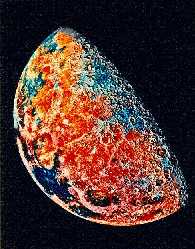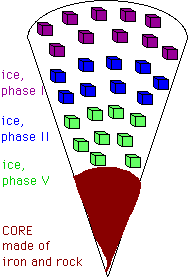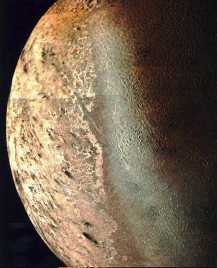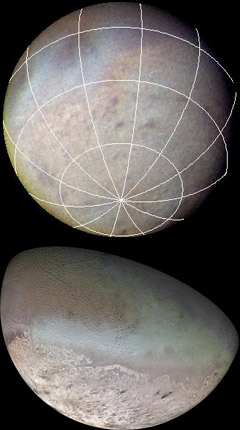This is an image of Triton.
Click on image for full size
NASA
Triton Composition
Composition is generally determined by detailed measurements of the
spectra of an object. Spectral measurements of the surface of Triton reveal the presence not only of ice but of several different kinds of snow (crushed ice).
The interior composition can only be guessed. Voyager 2 did not pass very close to Triton, therefore the density, from which a general idea of composition can be made, cannot be determined. A good guess is that Triton is made of ice throughout it's interior, except for a small core of rocky material. There may be a small layer of water inside Triton, however. This depends on how much of Triton is rocky and could help warm Triton. A small layer of water could provide an environment for life. Only more exploration will help us know for sure if these things are possible.
The fact that this moon is made primarily of ice suggests a certain path for it's evolution.
You might also be interested in:

How did life evolve on Earth? The answer to this question can help us understand our past and prepare for our future. Although evolution provides credible and reliable answers, polls show that many people turn away from science, seeking other explanations with which they are more comfortable.
...more
Minerals of a planet's surface, and molecules of an atmosphere emit light of various wavelengths. The wavelengths of light which minerals or molecules emit is characteristic of each individual mineral
...more
The diagram to the left shows a cutaway of the possible interior structure of Triton. The composition of Triton is mostly ice, therefore there is probably a small core of some rocky material buried inside,
...more
Triton is a little bit like Jupiter's moon Europa, and a little bit like Saturn's moon Titan. There is a very thin atmosphere which is a bit like Titan's. It is very cold, about -300 degrees. Like the
...more
Triton was discovered by W. Lassell in 1846. Of the 8 moons, it is the 2nd farthest from Neptune, with a standoff distance of 354,800 km. Triton may be one of the largest of the icy moons, is comparable
...more
Composition is generally determined by detailed measurements of the spectra of an object. Spectral measurements of the surface of Triton reveal the presence not only of ice but of several different kinds
...more
This gorgeous image of Triton reveals many interesting features of its surface. The surface of Triton is halfway between that of Ganymede and that of Europa, of the Galilean satellites. There are portions
...more
Triton is by far the largest moon of Neptune, and is one of the most unusual large moons in the Solar System. The poles of Triton are especially interesting. Triton has a frozen polar cap with ice geysers.
...more











